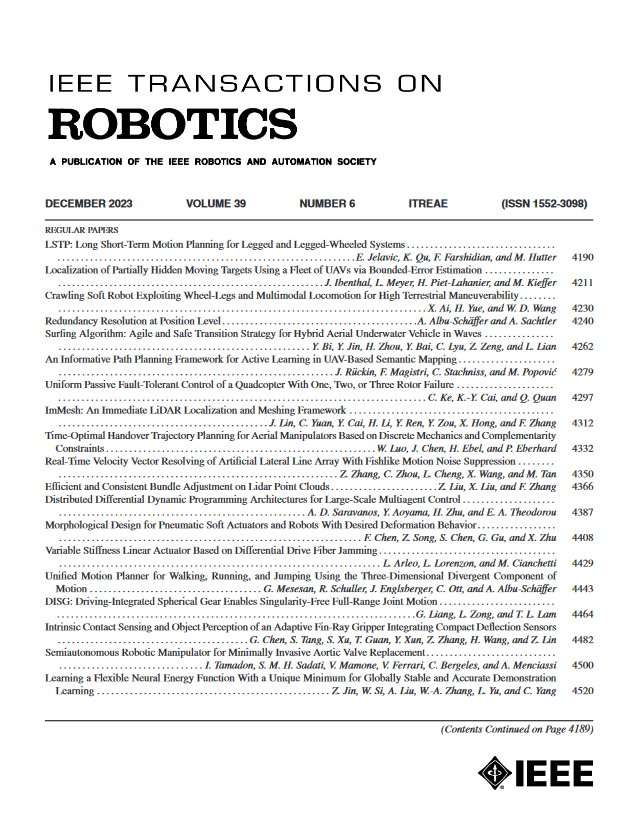梦境:混乱环境下无碰撞多机器人导航的分散实时异步概率轨迹规划
IF 10.5
1区 计算机科学
Q1 ROBOTICS
引用次数: 0
摘要
在具有静态和动态障碍物的杂乱环境中实现无碰撞导航是许多多机器人任务的关键。动态障碍物也可能是交互式的,即它们的行为会根据其他实体的行为而变化。我们提出了一种新的动态障碍物交互行为表示和一种分散的实时多机器人轨迹规划算法,允许机器人之间的碰撞避免以及静态和动态避障。我们的规划器模拟了动态障碍物的行为,考虑了交互性。我们考虑了静态障碍物的感知不准确和动态障碍物的预测不准确。我们处理队友之间的异步计划和消息延迟、丢失和重新排序。我们使用25400个随机案例在模拟中评估我们的算法,并将其与使用2100个随机案例的三个最先进的基线进行比较。与最佳基线相比,我们的算法在单机器人情况下使用低至0.28倍的时间达到了1.68倍的成功率,在多机器人情况下使用低至0.36倍的时间达到了2.15倍的成功率。我们在真实的四旋翼飞行器上实现我们的规划,以显示其在现实世界中的适用性。本文章由计算机程序翻译,如有差异,请以英文原文为准。
DREAM: Decentralized Real-Time Asynchronous Probabilistic Trajectory Planning for Collision-Free Multirobot Navigation in Cluttered Environments
Collision-free navigation in cluttered environments with static and dynamic obstacles is essential for many multirobot tasks. Dynamic obstacles may also be interactive, i.e., their behavior varies based on the behavior of other entities. We propose a novel representation for interactive behavior of dynamic obstacles and a decentralized real-time multirobot trajectory planning algorithm allowing interrobot collision avoidance as well as static and dynamic obstacle avoidance. Our planner simulates the behavior of dynamic obstacles, accounting for interactivity. We account for the perception inaccuracy of static and prediction inaccuracy of dynamic obstacles. We handle asynchronous planning between teammates and message delays, drops, and reorderings. We evaluate our algorithm in simulations using 25400 random cases and compare it against three state-of-the-art baselines using 2100 random cases. Our algorithm achieves up to 1.68× success rate using as low as 0.28× time in single-robot, and up to 2.15× success rate using as low as 0.36× time in multirobot cases compared to the best baseline. We implement our planner on real quadrotors to show its real-world applicability.
求助全文
通过发布文献求助,成功后即可免费获取论文全文。
去求助
来源期刊

IEEE Transactions on Robotics
工程技术-机器人学
CiteScore
14.90
自引率
5.10%
发文量
259
审稿时长
6.0 months
期刊介绍:
The IEEE Transactions on Robotics (T-RO) is dedicated to publishing fundamental papers covering all facets of robotics, drawing on interdisciplinary approaches from computer science, control systems, electrical engineering, mathematics, mechanical engineering, and beyond. From industrial applications to service and personal assistants, surgical operations to space, underwater, and remote exploration, robots and intelligent machines play pivotal roles across various domains, including entertainment, safety, search and rescue, military applications, agriculture, and intelligent vehicles.
Special emphasis is placed on intelligent machines and systems designed for unstructured environments, where a significant portion of the environment remains unknown and beyond direct sensing or control.
 求助内容:
求助内容: 应助结果提醒方式:
应助结果提醒方式:


